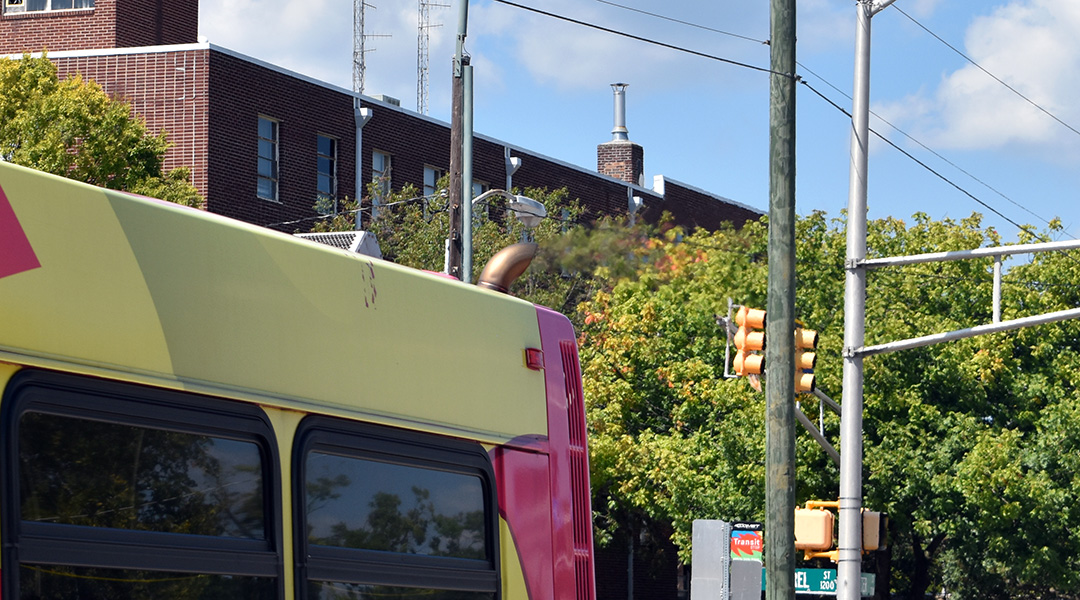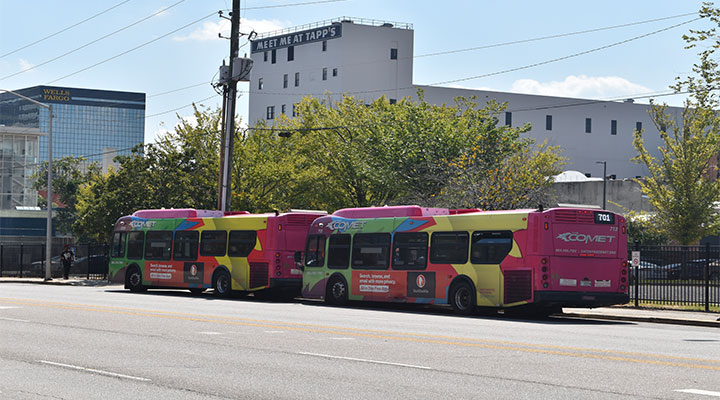COMET buses soon could expel less – or no – exhaust into the city air. (Photos by Stephen Pastis)
Columbia’s public transportation system is close to adding four low- and no-emission buses to its fleet — its first ever.
The additions are an investment the COMET will use to decide whether it is worth it to add more. While the new buses are expensive, many predict they will prove beneficial in the long run.
“I used to bicycle behind COMET buses from time to time, and I always hated it when they punch the gas and that big cloud of fumes hit me in the face,” said Penny Cochran, an organizing representative for the Midlands branch environmentalist group the Sierra Club.
Cochran is optimistic.
“From an environmentalist’s point of view, we’re absolutely thrilled to hear that the Central Midlands Regional Transit Authority is moving in this direction,” Cochran said. “This is something that the Sierra Club in particular has been pushing them towards for quite some time. And we’ve been lucky that we have found the (COMET’s) executive director and the board’s response to be very open and very interested in electrifying their bus fleet.”
Electric vehicles are more expensive to purchase than diesel, but the technology saves money over time and can be an energy resource well worth the investment, experts have said. Electric buses are typically more efficient, quieter, require less maintenance, produce no emissions and last longer.
Beyond those benefits, any step away from polluting vehicles is a step forward, Cochran said.
But whether that’s true will be tested next year when the buses arrive, likely at the end of 2023, according to Michelle Ransom, the grants and regional coordination manager for the COMET. Once the buses are on the road, the COMET will collect data on fuel and cost efficiency.
This test is the product of a nearly $3 million federal grant from the Federal Transit Authority, which regulates the organization and its fleet, to build low or no emission buses, in 2021. The grant will pay for two electric buses, two hydrogen fuel cell buses, new facilities, and research on the new vehicles.
The COMET experimented with hydrogen fuel cell technology in the late 2000s but eventually took the buses off the road.
The organization wanted a chance to test out the upgraded technology and see how it compares to electric, Ransom said.
Cochran applauds the city’s conservatism in choosing both to test.
Estimates say the buses will improve the air quality in Columbia, decrease yearly fuel consumption by about 34,700 gallons and reduce the annual greenhouse gas emissions by about 9.1 tons, according to the COMET grant proposal.
The technologies are changing quickly, said Conor Harrison, an associate professor at USC who studies infrastructure and the relationship between energy and society.
“In terms of vehicle electrification, it’s astounding how much it’s going to happen in the next decade,” Harrison said.
Once on the road, the four vehicles will spend the next year driving the city streets and collecting data, which then will be summarized in a final report that will dictate the COMET’s next steps.
“The theory is that electric is going to be the way to go, but we need to test it and be sure,” Ransom said. “If it works for us, then that’s what we’ll lean towards. But if something new comes along, you know, within five or 10 years, we’re always changing, we’ll dip into that as well.”
The new electric technology already has arrived in other parts of the state.
Greenville’s transit system, Greenlink, received a similar grant for four electric buses in 2017 and is now in the process of adding six more buses, according to Greenlink.
Greenville’s transit agency, however, has a smaller fleet to manage and a smaller terrain to cover, said Rosalyn Andrews, the director of finance and accounting at the COMET. The Greenville-Clemson-Seneca area benefits by having local relationships with Proterra — a commercial electric vehicle manufacturer with a factory in Greenville — and the engineering programs at Clemson University.
Seneca, just outside Greenville, rolled out one of the first fully electric fleets in the world in 2015 with six buses, according to Holly Brown, an administrative assistant with CATBus, Clemson’s public transit system, which is a close partner to the Seneca system.
The two comprise a fleet of 29 buses in the area, with Clemson adding 10 electric buses, with more on the way, Brown said.
In the Lowcountry, Charleston’s public transit system, CARTA, committed this year to fully transitioning its nearly 100-vehicle fleet to electric by 2040, according to a June release. CARTA’s first electric bus rolled out in 2019. It now operates six and has more on the way, according to the release.
Getting the buses on the road takes time, however.
“Just because we were awarded a grant does not necessarily mean the check is in the mail – and it’ll be here next week or next month, even,” said Pamela Bynoe-Reed, director of marketing and community affairs at The Comet. “All of that is a synchronized process that we have little control over, other than to submit the things that we’re supposed to submit.”
Columbia currently doesn’t have electric buses because of timing — each bus has a federally regulated lifetime lasting typically between seven and 12 years. As buses retire, new ones can take their place. The city also applied for the grant for four years — finally getting it in 2021.
“I think we were poised to begin a full-fleet replacement, or we’re approaching that point,” Ransom said. “And perhaps the FTA noticed that and saw and hoped to have a better analysis of what would be best fit for our region.”
The current fleet of vehicles is relatively up-to-date, according to Bynoe-Reed. But the new buses are still a step toward improvement.
“I would say for the buses and us getting us up to that level, it’s a big deal,” Andrews said.





